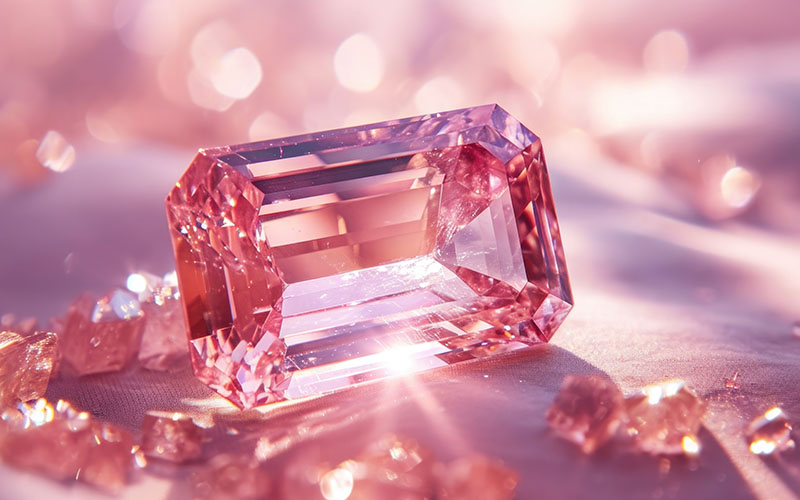Americans will eat 150-million hot dogs today. And right now, at this moment, there are delicious hot-dog, hamburger, steak and brisket barbecues occurring across the USA. There are potato salads, crisps and coleslaw. There’s corn on the cob and baked beans. A bit later there will be cupcakes, ice-cream and other sweet treats. Families will safely gather for games, backyard movie-nights, sparklers and fireworks shows.
Speaking of sparklers
Let’s mark America’s birthday by revisiting the sparkle of three American gemstones, all local to the USA, in her three patriotic colors, and representing the most popularly celebrated gemstone mineral species: Diamond, corundum and beryl.
Red from Utah

Red beryl, also known as bixbite or “red emerald,” is an exceptionally rare gemstone. Its discovery traces back to the early 20th century in the Wah Wah Mountains of Utah, USA. The first notable find occurred in 1904 by Maynard Bixby, after whom the stone was initially named. Unlike other beryls, which come in various colors due to different impurities, red beryl owes its rich, raspberry-red hue to trace amounts of manganese.

Historically, red beryl has fascinated gemologists and collectors due to its scarcity and vibrant color. The Utah deposit remains the only significant source of gem-quality red beryl, although smaller occurrences have been noted in Mexico and New Mexico. The mining of red beryl is arduous, with only a minuscule fraction of the extracted material suitable for faceting into gemstones.
Red beryl is estimated to be 1,000 times more valuable than gold by weight, underscoring its rarity. Its allure is amplified by its striking color and the fact that it forms under highly specific geological conditions, requiring both beryllium and manganese to be present in a host rock under particular temperature and pressure conditions. This combination makes red beryl one of the most coveted and elusive gems in the mineral world.
White from Arkansas

The Esperanza Diamond, an exceptional gem, was discovered on June 16, 2015, at the Crater of Diamonds State Park in Arkansas, USA, a unique public diamond-bearing site which allows visitors to search for and keep any gemstones they find. Confirmed to be Type IIa (Golconda) D color, which is the most colorless, whitest diamond material, it’s clarity was graded internally flawless. The amazing Esperanza, named after the Spanish word for hope as well as the niece of the diamond’s finder, weighed 8.52 carats in the rough.

After its discovery, the diamond underwent expert analysis and planning. Ultimately a unique cut was designed specifically for this gem. The result was a triolette shape, a design featuring three main facets to enhance the stone’s brilliance and fire. The finished diamond weigs 4.60 carats.
Today, the Esperanza Diamond stands as a symbol of Arkansas’s rich geological heritage. Its availability is limited to exhibitions and private viewings, making it a rare and highly sought-after piece among collectors and diamond enthusiasts worldwide.
Read more about the Esperanza Diamond’s roller-coaster journey in our prior GemBlog post: The Esperanza Diamond is still for sale
Blue from Montana

Montana sapphires, renowned for their stunning colors and unique characteristics, were first discovered in 1865 by gold miners in the gravel bars along the Missouri River near Helena, Montana. These miners, in their quest for gold, stumbled upon colorful gemstones that would later be identified as sapphires.

The history of Montana sapphires is intertwined with the American frontier’s gold rush era. By the 1890s, significant sapphire deposits were found in the Rock Creek, Dry Cottonwood Creek, and the Yogo Gulch areas. Of these, the Yogo sapphires are particularly famous for their cornflower blue color and exceptional clarity, often free from heat treatment.
Today, Montana sapphires are highly prized by gem enthusiasts and jewelers. Compared to other sapphire sources worldwide, Montana’s production is relatively limited, enhancing their exclusivity.Their American origin, combined with their distinctive beauty and the romantic history of their discovery, makes them sought-after gemstones in the global market. As a result, these sapphires hold a special place in the world of fine gems, celebrated for their rarity and allure.
Three American Rock Stars
And there you have it. All USA-born and bred (or polished, as it were). I would like to close by noting that all of the red, white and blue sparklers I have featured above are available for enthusiastic bidders to track down. You’re free to chase the entire patriotic collection.
Happy birthday USA. Enjoy the fireworks (and the hot dogs!)





